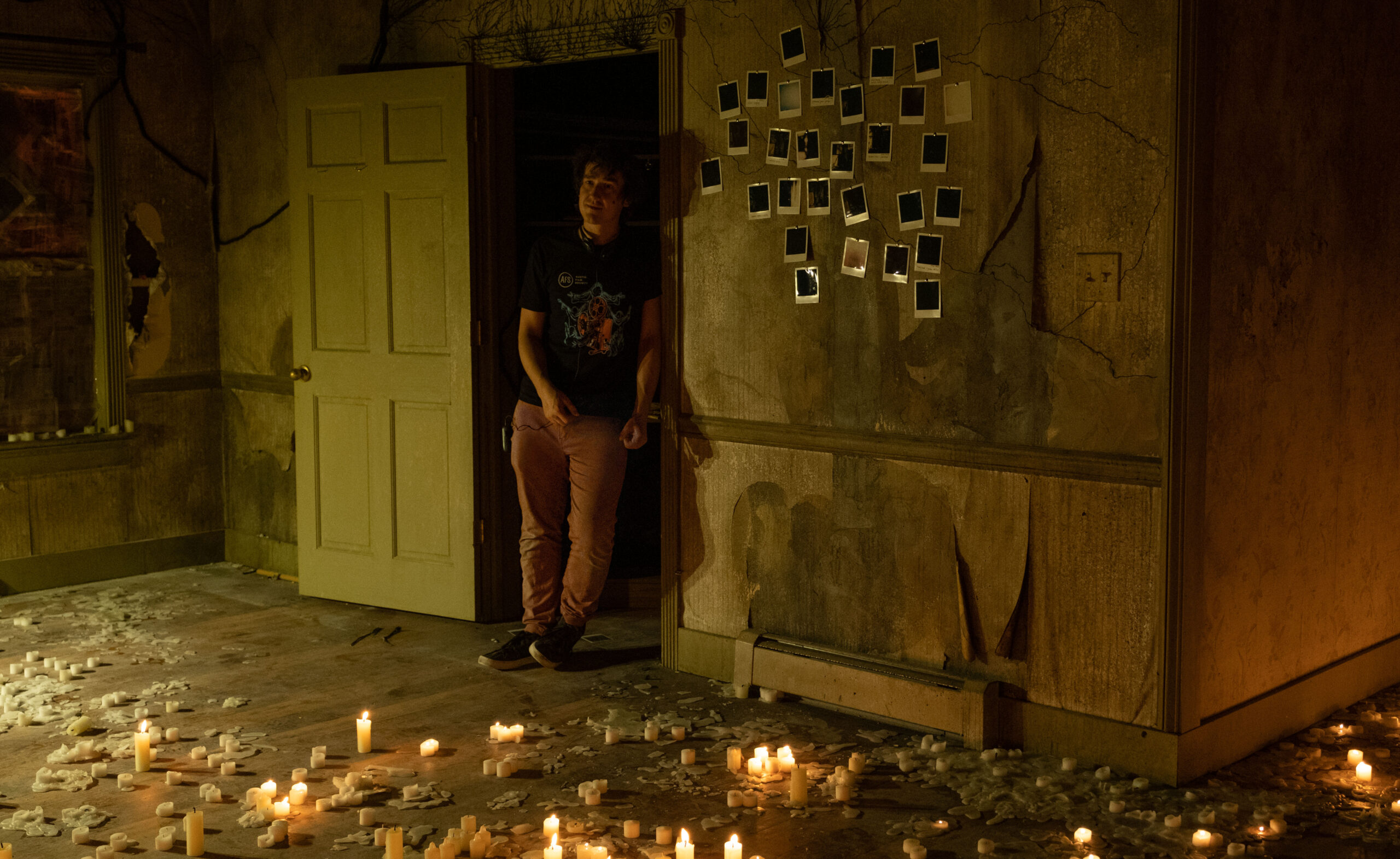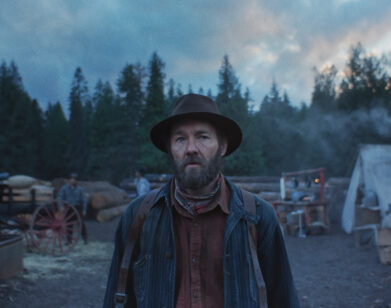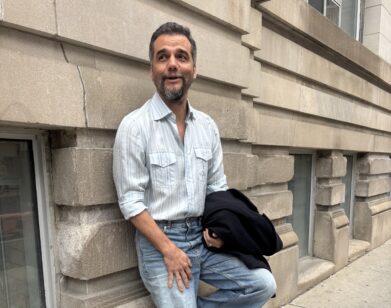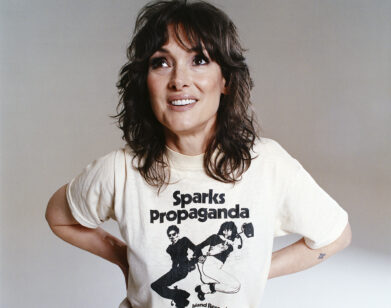DIRECTOR
Rob Savage and Sam Raimi on The Boogeyman and the Terror of Test Screenings

Director Rob Savage on the set of 20th Century Studios’ BOOGEYMAN. Photo Patti Perret. © 2023 20th Century Studios. All Reserved.
In 2020, Rob Savage announced himself as a horror director to watch with Host, a low-budget shocker that was shot entirely on Zoom, and is still one of the only truly good movies about our pandemic lives. After following that up with another found footage-style indie Dashcam, Savage is back with The Boogeyman, a Stephen King adaptation about a grieving family who may or may not have a demonic entity terrorizing them. The movie marks Savage’s first with a major studio, which means bigger budgets and bigger scrutiny. To talk about that sometimes scary process, Savage connected with one of his heroes, the horror maestro Sam Raimi.
———
ROB SAVAGE: Hey, Sam.
SAM RAIMI: How are you, Rob?
SAVAGE: I’m very well. How are you?
RAIMI: Good to see you. Great job with your movie.
SAVAGE: Oh, thank you. When did you watch it?
RAIMI: Yesterday and last night. I saw it one and a half times to get ready. Brilliant camera work, great technique, fantastic performances from the actors.
SAVAGE: Aren’t they incredible?
RAIMI: They were all great. I’m not a great interviewer, but I’ve got some questions. I’m going to shut off the camera, so I can really focus on my notes and not be worrying about being on the show.
SAVAGE: For sure. Maybe I’ll do the same.
RAIMI: Great. We’ll just do freeform. I saw the movie last night and it was really a great theatrical experience. I saw it on a home screen, but I could imagine that being in the crowd, there would’ve been people on the edge of their seat, brought to the peak of titillation. And then sometimes you didn’t deliver. I could feel that if I was in that crowd, they would all kind of relax a bit and then sometimes you hit us with a scare without any setup.
SAVAGE: Yeah.
RAIMI: I thought that beyond your other films, you were playing with the rhythms that a director uses to manipulate an audience. Do you have any comments on that?
SAVAGE: I wanted to make sure that we weren’t just playing the same scare over and over. Just before we started shooting, I got a bunch of different color cards and I put up all the different scares on the wall, and I had them in different colors for the different kind of scare, one that was coming out in the blue, one that was more of a jump scare, scares that were more about building tension and more of a kind of hide-and-seek dynamic. I also had movies playing constantly in the background of my office when we were prepping, movies that I wanted to try and emulate. I like the audience to feel unsafe, even if it was a scene in the daytime, which is normally code in horror movies for, “You’re safe, you can check your phone, you can make a cup of tea.”
RAIMI: Have you seen the movie now in large audiences in the theater?
SAVAGE: No, in fact, I found out the other day they were doing one of those screenings where they filmed the audience in night vision to get jump reactions. I found out there was one happening just five minutes from my house at the AMC in Burbank, so I snuck in with the big trench coat and sat at the back and watched everyone jump and scream and throw their popcorn.
RAIMI: That’s awesome. I bet that’s really the way to see this movie, because I could feel the nonexistent people around me really loving this. You were originally intended as a streamer, and then what changed? How did you break out and convince the great, grand 20th Century Fox to release your film as a theatrical?
SAVAGE: I think it was the test screening process, which I was terrified of originally because this was my first studio movie. Everything else I’d done, I had final cut on because we made it for pennies. We were heading into our first preview, we had animatics in place of our creature because our creature’s full CGI, and I was just sure that it was going to tank. Until this point, the producers and the studio had been amazing to collaborate with, and I was worried that we’d have this awful test screening and then suddenly like vultures, everyone would swoop in with an idea of how the film needed to be fixed. But you could tell within the first five minutes that the audience was locked in. We have a pretty shocking early scare, and the audience just gasped and went totally silent.
RAIMI: Wow.
SAVAGE: From that moment, you could just tell they were with it. And then we previewed again and it scored even higher. Even though it took a few months to get the official word, I kind of knew in my gut that we wouldn’t end up on someone’s TV, we’d end up in a cinema. How do you like the test screening process? Because I know filmmakers who have mixed feelings.
RAIMI: I feel both ways. It’s absolutely the most unnerving night in a director’s life, is to finally see all of their dreams butchered with some temp soundtrack or temp picture with bad sound in front of an audience. But it’s also the most helpful thing to start communicating with the audience early, getting their feedback. For me, it’s like a detective job. Why didn’t it work this time? What did I omit or mess up in the timing that made it less effective?
SAVAGE: Right.
RAIMI: I want to talk about what you said earlier, which was about after the first number of minutes, you could feel the audience sink into the movie. Like you said, you can win the audience over in 10 minutes, and once a certain set of things are working, whether it’s identification with the character, understanding their plight, liking them, a fear of what it is that’s threatening them, is there is a certain number of boxes that you can check, and then you have a sense that the audience is rooting for you the rest of the way?
SAVAGE: I don’t know. I wish I had a formula for that. The two things I really wanted to hit with this movie is I wanted to have a really powerful cold open that showed the audience we weren’t fucking around. I wanted to make sure the audience felt unsafe and unsure as to how far this movie was going to go. We’ve got a pretty shocking scene at the beginning involving the creature and a young child, and the audience has been conditioned to think that child’s going to be okay, that there are certain rules that we’re going to abide by in terms of how far we go with the horror. And I wanted that opening scene to get a gasp. You set off with the audience knowing that this movie’s going to go hard.
RAIMI: Another way of saying that is, “Folks, the director is unstable.”
SAVAGE: [Laughs] Exactly. I want it to feel like a madman was behind the lens.
RAIMI: “I’ll kill us all. I’ll push things over the edge.”
SAVAGE: I want them to feel like my finger’s on the button the whole time. My pitch to the studio was that it was going to be somewhere between Ordinary People and Poltergeist.
RAIMI: You’re a dangerous storyteller and we’re in your hands. I have to see it on the big screen with a crowd now.
SAVAGE: The big screen thing is real and I felt like with a title like The Boogeyman and Stephen King’s name floating above it, there was a good chance that if I didn’t fuck it up, it could end up in theaters. I was always directing it with the big screen in mind. I don’t think any filmmaker can really direct with TV in mind. I knew there’d be a real power in opening the movie proper on that shot of Sophie [Thatcher]. It felt like if we could fill the screen with Sophie’s face and feel the authenticity of her performance in that moment in her grief, an audience couldn’t help but immediately latch onto her and empathize with her.
RAIMI: I really did. How did you find Sophie Thatcher, as Sadie?
SAVAGE: She’s incredible. It’s probably pretty similar to Bruce in the Evil Dead movies, although she’s covered in blood a lot less, but the level of physicality and the emotional demand on her performance didn’t really hit me until we were a couple of weeks in. She’s almost in every single shot of the movie, and she’s got to do some pretty heavy lifting in terms of the dramatic scenes. She’s got to authentically portray this character in the spiral of grief, and then in the scare scene, she’s sobbing and screaming and fighting and being bashed around. We kind of developed a second language. I was able to go up to her and communicate with a series of grunts and she’d totally get what meant.
RAIMI: She was super successful as an action heroine, as a sensitive teenage high school lead, relative to her girlfriends and cliques that would and would not deal with her. But she was also great as a sister to that young lady. The two of them really seemed like they had this fraternal relationship.
SAVAGE: And it was really her job to make us feel that we weren’t just kind of telling a silly, flippant, monster movie. You had to feel the burden of the loss she’s been through for that ending to work.
RAIMI: That was great.
SAVAGE: Potentially cheesy, but very heartfelt.
RAIMI: You showed a very skilled hand as a director in the dramatic scenes. It was very well-done with the actors and your subtle touch.
SAVAGE: While I’m thinking about that, I’ve got a question for you.
RAIMI: Yes, sir.
SAVAGE: Well, two of the things that I admire most in your movies are your command of pace and tone, but tone especially. Tone was something I was thinking a lot about in this movie and in the last couple of movies I’ve made as well, which is, it’s something that’s kind of easy to control from a directorial standpoint when you’re talking about the visuals, when you’re talking about the overall aesthetic of the movie. But I wondered if you could speak to how you communicate tone with your actors, because I was lucky that most of my cast were film buffs, and I was able to talk in movies with them and they could get a sense of what I was doing. I wonder how you try to invite your cast into your vision of the movie and the tone you’re trying to set?
RAIMI: That’s a good question. I don’t think I have any technique that I’m aware of. I usually just work on the script with my brother Ivan. When I’m on the set, I treat everything as though it’s real, even though I laugh at times because it’s so absurd. It’s never about the humor or the tone. It’s always about keeping it, I hate to say this, keeping it real within whatever reality is chosen.
SAVAGE: One of the hard lines to walk with comedy and horror is that if you feel like everyone is winking at you, then none of the horror lands because none of it comes from a place of authenticity.
RAIMI: I guess when you talk about the early movies, we were much more over the top, Bruce Campbell and I. What I’m saying now is not true of the later movies I’ve made, where we’re in on the joke with the audience and we’re hoping that they get it. And if they don’t, that’s okay.
SAVAGE: But even the performances in Evil Dead 2, you believe that they believe it. There’s no sense of being nudged in the ribs and saying, “Yeah, we know we’re in a movie.” But in terms of the performances, they’re big, but they’re still of a piece with the world.
SAM RAIMI: Yes. That is what we were trying for. It’s only Bruce Campbell who occasionally, with his bigness, breaks out of that box with his cheesy one-liners.
ROB SAVAGE: I’d much rather talk about Evil Dead 2 because it was a huge movie for me. It still is. It’s probably the reason that all of my movies come in so short, because that movie’s like 82 minutes and there’s not an ounce of fat on it. In the last three movies that I’ve done, it’s been my intention that there’s no scene where you feel like you can go to the bathroom safely and you’re going to miss something that you’ll catch up on five minutes later.
RAIMI: If The Boogeyman was a detergent, I would add the label, “Concentrated now.”
SAVAGE: Exactly.






